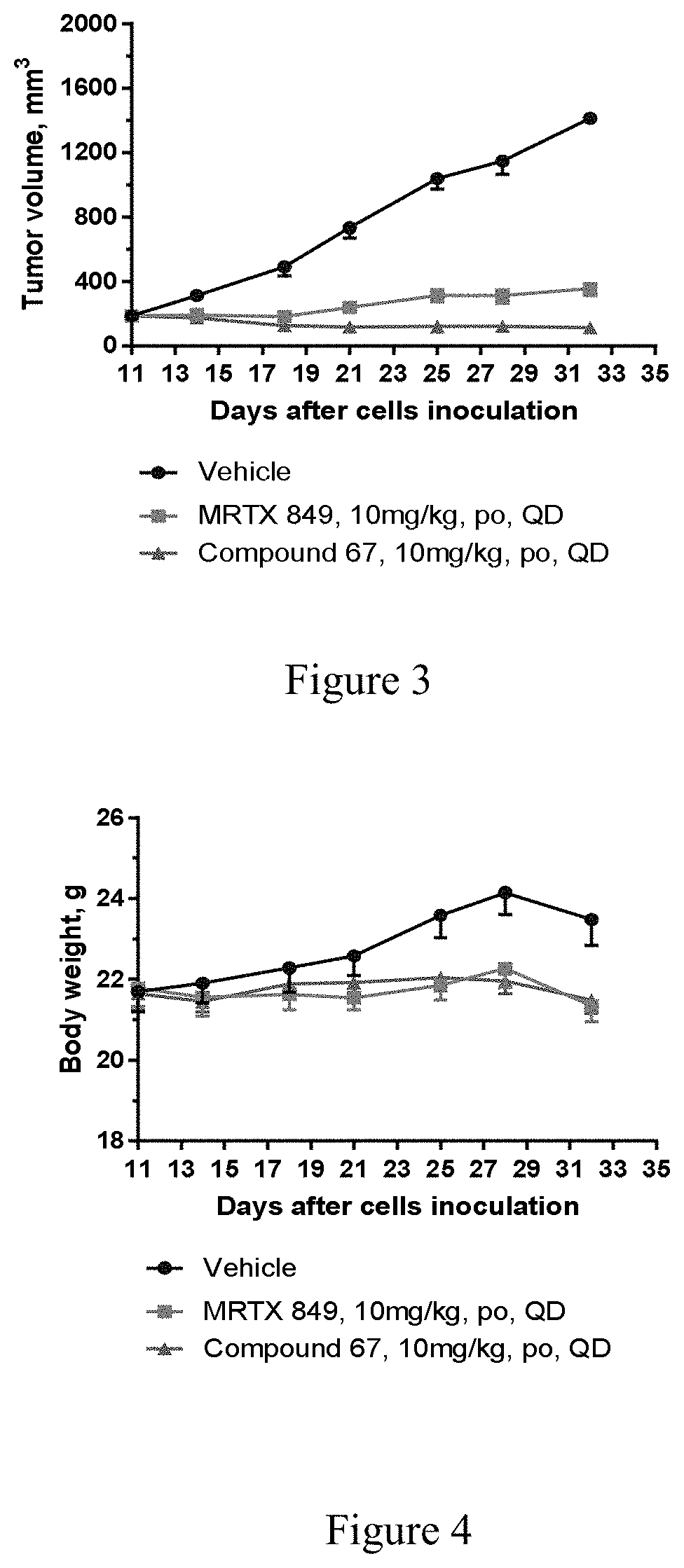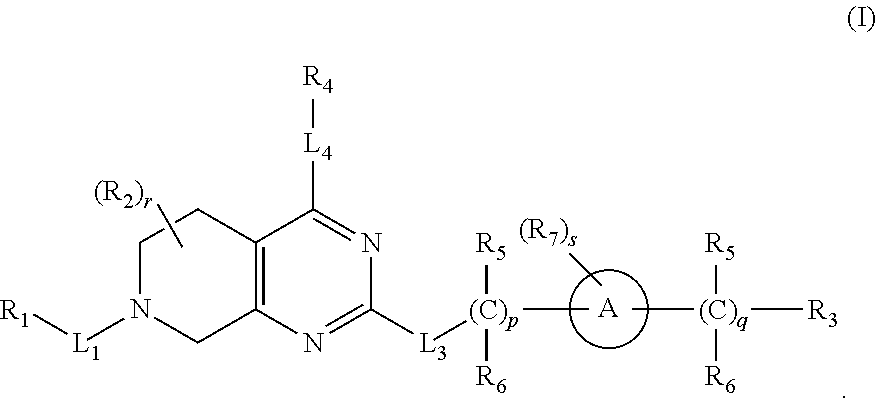Kras mutant protein inhibitors
a technology of mutant proteins and inhibitors, applied in the field of mutant protein inhibitors, can solve the problem of challenging the target of this gene with small molecules
- Summary
- Abstract
- Description
- Claims
- Application Information
AI Technical Summary
Benefits of technology
Problems solved by technology
Method used
Image
Examples
example 1
[0267]
[0268]Step a: To a mixture of Intermediate A1 (300 mg, 0.62 mmol), (1r,4r)-4-(dimethylamino)cyclohexan-1-ol (140 mg, 0.98 mmol) and sodium tert-butoxide (170 mg, 1.77 mmol) in toluene (10 mL) was added BINAP (65 mg, 0.10 mmol) and Pd2(dba)3 (55 mg, 0.06 mmol) and the mixture was purged with nitrogen followed by stirring at 95° C. for 2.5 h. The mixture was diluted with ethyl acetate (30 mL) and water (40 mL) and the organic layer was separated. The organic layer was washed with brine (40 mL) and dried over anhydrous Na2SO4, filtered and concentrated under reduced pressure. The residue was purified by Pre-TLC (DCM:MeOH=9:1) to give Compound 1-1 (239 mg, 0.41 mmol). MS: m / z 590 [M+1]+.
[0269]Step b: To a solution of Compound 1-1 (229 mg, 0.39 mmol) in MeOH (10 mL) was added Pd / C (375 mg, 10%). The suspension was degassed under reduced pressure and purged with H2 three times. The mixture was stirred under H2 at 60° C. for 1 h. The mixture was filtered and the filter cake was washe...
example 56
[0274]
[0275]Step a: To a solution of Intermediate D1 (87 mg, 0.13 mmol) in DCM (10 mL) was added TFA (1 mL). The reaction mixture was stirred at 25° C. for 3 h. Upon completion, the reaction mixture was concentrated under reduced pressure. The residue was dissolved in DCM (10 mL). To the solution was added TEA (0.5 mL) and acryloyl chloride (46 mg, 0.51 mmol), then the mixture was stirred at 25° C. for 40 minutes. Upon completion, the mixture was concentrated under reduced pressure. The residue was purified by Pre-TLC (DCM:MeOH=10:1) to give Compound 56 (34 mg) as a yellow solid. MS: m / z 606[M+H]+, 1H NMR (400 MHz, DMSO-d6) δ 7.76 (d, 1H), 7.73-7.66 (m, 1H), 7.52-7.41 (m, 1H), 7.41-7.24 (m, 3H), 6.94-6.77 (m, 1H), 6.19 (d, 1H), 5.78 (d, 1H), 4.10 (d, 2H), 4.08-3.79 (m, 4H), 3.79-3.55 (m, 2H), 3.42 (d, 2H), 3.29-3.16 (m, 2H), 3.16-3.02 (m, 4H), 2.98-2.89 (m, 1H), 2.86 (s, 3H), 2.81-2.57 (m, 2H), 2.47-2.24 (m, 4H), 1.81-1.49 (m, 4H), 0.70-0.22 (m, 4H).
[0276]The following Compounds wer...
example 68
[0277]
[0278]Step a: To a solution of intermediate D3 (0.97 g, 5 mmol) in DCM (1 mL was added TFA (3.5 mL). The reaction mixture was stirred at 25° C. for 1 hour. Upon completion, the reaction mixture was concentrated under reduced pressure. The residue was dissolved in DCM (10 mL). To the solution was added DIEA (4.0 mL), then Intermediate E1 (803 mg, 7.72 mmol) and HATU (2.99 g, 7.86 mmol) were added, and the mixture content was stirred at 25° C. for 0.5 hour. The reaction mixture was concentrated under reduced pressure, the residue was purified by silica gel (50-30% DCM in MeOH) to provide crude. The crude was further purified by Pre-HPLC (column: Daisogel-C18-10 um-100 A; mobile phase: [water (20 mmol NH4HCO3)-ACN]; B %: 30%-60%, 30 min) to give Compound 68 (196 mg, 0.32 mmol, 20.78% yield) as an off-white solid. MS: m / z 612 [M+H]+. 1H NMR (400 MHz, MeOD) δ 7.83-7.62 (m, 2H), 7.55-7.17 (m, 4H), 7.09-6.48 (m, 2H), 5.41-5.01 (m, 2H), 4.48-3.91 (m, 6H), 3.88-3.43 (m, 4H), 3.28-3.04 ...
PUM
 Login to View More
Login to View More Abstract
Description
Claims
Application Information
 Login to View More
Login to View More - R&D
- Intellectual Property
- Life Sciences
- Materials
- Tech Scout
- Unparalleled Data Quality
- Higher Quality Content
- 60% Fewer Hallucinations
Browse by: Latest US Patents, China's latest patents, Technical Efficacy Thesaurus, Application Domain, Technology Topic, Popular Technical Reports.
© 2025 PatSnap. All rights reserved.Legal|Privacy policy|Modern Slavery Act Transparency Statement|Sitemap|About US| Contact US: help@patsnap.com



